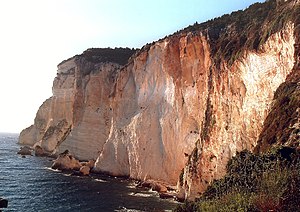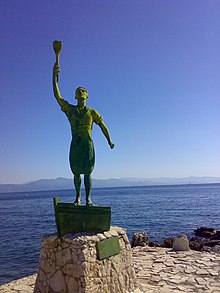Paxos
| Paxos | ||
|---|---|---|
| Eremitis cliff on the west coast | ||
| Waters | Mediterranean Sea | |
| Archipelago | Ionian islands | |
| Geographical location | 39 ° 12 '27 " N , 20 ° 9' 41" E | |
|
|
||
| length | 10 km | |
| width | 3 km | |
| surface | 19 km² | |
| Highest elevation | 248 m | |
| Residents | 2280 (2011) 120 inhabitants / km² |
|
| main place | Gaios | |
| Port of Gaios | ||
Paxos ( Greek Παξός ) is a Greek island within the island group and municipality of Paxi , which belongs to the group of Ionian Islands . Paxos is the smallest of the main islands in this group of islands.
Paxos is about 10 kilometers long and only a few places wider than two kilometers. The highest point on the 19 square kilometer island is 248 meters high. On Paxos there are no constantly water-bearing streams and hardly any springs.
A few kilometers east on the mainland is the small port of Parga .
About two and a half kilometers south of the main island is Andipaxos , a small island that is only permanently inhabited by 20 residents (2011).
The main source of income for the island's inhabitants used to be the cultivation of very small but particularly aromatic olives and the production of high-quality olive oil. Today tourism plays the leading role in the working life of the population. On Andipaxos, on the other hand, hardly any olives are cultivated, whereas two thirds of the island are covered with vines , which, in addition to average table wines, increasingly also produce quality wines.
A good half of the approximately 3000 inhabitants of Paxos live in the capital Gaios , in the southeast of the island. Ferries from Italy, Corfu and Igoumenitsa dock in the port, which is well protected by the two islets Panaghia and Agios Nikolaos . The seaside resorts of Lakka and Longos are to the north and northeast respectively . Scattered in the interior of the island there are some hamlets and smaller settlements; Magazia is the most important of them.
The east of the island is rather flat and rich in very beautiful bathing bays, the west coast drops in abruptly steep drops and cliffs to the sea. There are also some grottos and towering monoliths slightly off the coast, such as the Ortholithos .
Mythology and history
According to legend, Poseidon separated the island from the southern tip of Corfu with his trident in order to create a protected love nest for himself and his lover Amphitrite . That is why the trident is the island's emblem.
There are no traces of human activities on the island from prehistoric times, but Paxos was at least temporarily settled during the Greek migrations. It is very likely that Paxos, like some other Ionian islands, was a Phoenician colony in the first centuries of the 1st millennium BC.Many suggests that the name Paxos also goes back to the Phoenician word paks , which means trapezoidal and the island shape as seen from the sea. Subsequently, Paxos shares the fortunes of the large neighboring island of Corfu.
The occupation of Corfu and the neighboring islands by Illyrian pirates in 229 BC BC led to Rome's first direct intervention in Greek affairs. 31 BC After the lost naval battle at Actium , Marcus Antonius and Cleopatra are said to have stayed in Gaios for a few days on the run .
The next thousand years are largely in the dark of history, but the settlement continuity never seems to have been broken. Liutprand from Cremona chose Paxos as his domicile to write his history in a quiet atmosphere. In 1386 Paxos fell to the Republic of Venice . In the course of the conflict of the West against the expansion of the Ottoman Empire , Paxos also suffered greatly. In 1537, Turkish troops under the command of Khair ad-Din Barbarossa sacked the island. The population was massacred or enslaved, only a few were able to save themselves on neighboring islands. In 1571 the island was again plagued and plundered by a Turkish fleet. In 1797 the rule of Venice ended.
From 1797, Paxos shared the fate of the other Ionian Islands. After a brief French occupation, it was conquered by Russians and Ottomans in 1799 . Tsar Paul I formed the Republic of the United Seven Islands from the islands . During the Napoleonic Wars , the islands were first occupied by the French (1806) - who founded the short-lived Ionian Republic here - and later by the British (1809/1810). In 1815 they transformed them as the United State of the Seven Ionian Islands into an independent state under British protectorate . The residents of Paxos took part very intensively in the Greek struggle for freedom . Georgios Anemogiannis is particularly venerated on Paxos . He fell as captain of a small battleship off Naupaktos at the age of 23 . In 1864 Paxos and the other Ionian Islands came to Greece at the request of the population and after a corresponding vote by the Ionian Parliament.
The hypothetical ancient Paxon parliament
In a scholarly article on distributed computing , Leslie Lamport invented a parliament on an island called Paxos in the Aegean (!); this attempt to add humor to a dry scientific article is viewed today by himself as a dismal failure .
His article posits that recent archaeological research has revealed information about the ancient parliament in Paxos. Parliamentarians in ancient Paxos only carry out their work sporadically. A set of rules created and mathematically tested by mathematicians of the time would have solved the problem of how reliable votes on laws would still have been possible.
Lamport developed this algorithm for voting in distributed computer systems; it has since been called the Paxos algorithm .
Web links
Individual evidence
- ↑ Results of the 2011 census, Greek Statistical Office (ΕΛ.ΣΤΑΤ) ( Memento from June 27, 2015 in the Internet Archive ) (Excel document, 2.6 MB)
- ↑ Lamport's writings (English)



